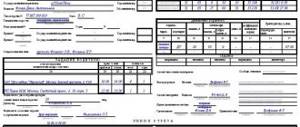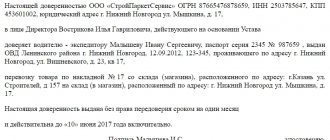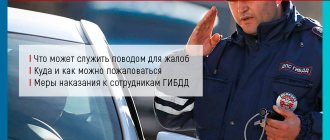Deadlines for issuing travel documents
From March 1, 2021, the Ministry of Transport of the Russian Federation introduced amendments (order No. 467 dated December 21, 2018), according to which a waybill can no longer be issued for more than a month.
They now need to be done before each flight if it lasts longer than a working day or shift. However, it is still allowed to issue one waybill if the driver manages to complete several trips within one work shift. You can issue waybills lasting more than one day only when the driver is sent on a multi-day flight. Such a flight can last even longer than a month.
As it was: previously, waybills were allowed to be issued for any period within a month. Although previously the Ministry of Transport of the Russian Federation recommended that they be issued for each flight.
Is it possible not to issue a waybill for every day?!
With its orders and clarifications regarding the transformation of the rules for issuing waybills, or rather, the vagueness of some formulations, the Ministry of Transport has created a fair amount of confusion. Someone came to the conclusion that from March 1, 2021, a waybill must be issued for every trip, regardless of the type of activity of the company and other circumstances. Some say that these standards are mandatory only for companies providing cargo transportation services. Finally, officials have clarified things and their explanations will please most accountants.
Let us recall the essence of the problem. According to paragraph 10 of the Mandatory details and the procedure for filling out waybills, approved by Order of the Ministry of Transport of the Russian Federation dated September 18, 2008 No. 152 (hereinafter referred to as the Procedure for filling out), organizations can issue a waybill for any period not exceeding a month, with the exception of professional carriers who issue it daily. In the new edition of the Filling Out Procedure (approved by order of the Ministry of Transport of the Russian Federation dated December 21, 2018 No. 467), which entered into force on March 1, 2021, mention of a period of 1 month is excluded.
Current
According to officials of the Russian Ministry of Finance, waybills should be drawn up at a frequency that allows one to judge the validity of expenses. Let’s say this can be done once a month, if the accounting of time worked and fuel consumption does not suffer (letters dated November 30, 2012 No. 03-03-07/51, dated February 20, 2006 No. 03-03-04/1/129, dated 04/07 .2006 No. 03-03-04/1/327, etc.). And these explanations from financiers are still relevant. As for the Order of the Ministry of Transport dated 08.08.2018 No. 296, which came into force in December last year and confused many minds, it dealt specifically with the daily marking of a pre-trip medical examination (specifically in transport companies).
At the same time, paragraph 4 of the Filling Procedure remained unchanged. It says that information about the validity period of the waybill includes the date (day, month, year) during which the waybill can be used, and if the waybill is issued for more than one day - the dates (day, month, year ) the beginning and end of the period during which the waybill can be used.
From the letter of the Ministry of Transport dated September 28, 2018 No. 03-01/21740-IS, the following conclusion could be drawn: a waybill is issued each time before the car leaves for a trip, with notes on pre-trip control measures being made. Moreover, this applies to any organization operating a vehicle.
However, in letter No. D3-514-PG dated 04/04/2019, officials “adjusted” their position, explaining that a waybill can be issued for any period (for example, a month), regardless of the number of flights. The main thing is to put in it:
— odometer readings when the vehicle leaves the parking lot (parking space), intended for parking upon returning from a trip and the end of the driver’s shift (working day);
— date and time of the car’s departure from the parking lot and its entry into the parking lot;
— date and time of pre-trip or pre-shift monitoring of the technical condition of the vehicle;
— date and time of the pre-trip and post-trip medical examination.
Registration of a waybill by affixing the above details to an already created waybill is possible provided that the remaining details of the waybill are kept unchanged.
The clarifications of the Ministry of Transport are aimed at eliminating the ambiguity resulting from the careless actions of the department itself when introducing changes to the Procedure for filling out waybills. In fact, the authors of the letter confirmed that, despite the exclusion of the direct rule that allowed the issuance of “long” waybills, this possibility remains due to the general provisions of the Order that a waybill can be used for several days. This means that companies can still issue one waybill for a month (or even for a longer period), but at the same time they need to ensure that each trip (flight) in such a waybill is recorded separately, including marks on completion medical and technical examinations for each departure.
note
Misinterpreted clarifications from the Ministry of Transport can create certain difficulties for companies. However, for the purpose of taxing profits, the opinion of the Ministry of Finance and the Federal Tax Service has priority, but it has not changed - the mood of officials, including tax officials (letter of the Federal Tax Service of the Russian Federation for Moscow dated November 14, 2006 No. 20-12/100253), is loyal. In addition, there are a number of court decisions, from which it also follows: waybills must be drawn up in such a way and with such regularity that on their basis one can judge the validity of the expenses incurred (resolution of the Federal Antimonopoly Service of the Volga-Vyatka District dated April 27, 2009 No. A38-4082 /2008-17-282-17-282, North-Western District dated 02/11/2009 No. A56-10236/2007, Central District dated 04/04/2008 No. A09-3658/07-29, etc.).
By the way, in the same letter (as well as in letter No. D3-531-PG dated April 8, 2019), the Ministry of Transport explained that one waybill can be issued for several drivers. In this case, identification of the marks of the medical worker who conducted the pre-trip (post-trip) medical examination must be ensured, in terms of their attribution to each driver of the vehicle. In other words, the waybill must contain notes indicating that each driver has undergone a medical examination.
Important
The required details of the waybill are: name and number of the waybill; information about the validity period of the waybill; information about the owner (holder) of the vehicle; information about the vehicle; driver information.
If several drivers are involved in trips, then the corresponding marks should be placed in such a way that it is clear which driver they refer to. For these purposes, as indicated by the Ministry of Transport, it is permissible to modify the form of the waybill (of course, while maintaining the required details).
Stay up to date with the latest changes in accounting and taxation! Subscribe to Our news in Yandex Zen!
Subscribe
Medical examination notes
The waybill must include information about the driver’s pre-trip and post-trip medical examinations.
The doctor records the date and time of the procedure, as well as his last name and initials. Each such mark is certified by the doctor’s signature. According to the new rules, it is no longer necessary to supplement the above with a special seal. However, this is required by the Procedure for conducting medical examinations (dated December 15, 2014 No. 835n), approved by the Ministry of Health, so it will still be safer to have it performed. As it was: in addition to the requirement to certify the medical examination data not only with a signature, but also with a stamp, the doctor had to enter his full name and patronymic. Abbreviations to initials were not permitted.
Odometer reading
Now kilometers traveled cannot be endorsed only with the stamp of an authorized employee.
From March 1, only one option is allowed - an employee’s signature with last name and initials. The list of required details now does not include odometer readings at the end of the voyage. However, the Filling Procedure (dated September 18, 2008 No. 152) still contains a clause stating that readings are taken twice. Therefore, it will be more reliable to record the odometer readings upon returning the car to the parking lot. As it was: they allowed two ways to certify odometer readings: a stamp or an employee’s signature. Now a signature has become mandatory. Also, one of the mandatory details was, along with the odometer readings at the time the car left the parking lot, there were also readings at the time it returned. Although now they are no longer mandatory details, they are still worth entering.
Introduction to the concept of parking
The first innovation is that in the text of the regulatory document the concepts of “garage (depot)” and “permanent parking place” are replaced with a single concept of “Parking (parking space)”.
Let me remind you that the concept of parking was introduced into the traffic rules on August 6, 2013, and into the law “On Road Safety” on May 12, 2021.
In this case, the order of the Ministry of Transport of the Russian Federation is brought into compliance with other regulatory documents.
Table 1. Fines for shortcomings in waybills
| What's the problem? | Who has the right to fine | Amount of fine | ||
| per company | for general director | per driver | ||
| No pre-trip or post-trip medical check mark | Rostrud (part 3 of article 5.27.1 of the Code of Administrative Offenses of the Russian Federation) | From 110,000 to 130,000 rubles. | From 15,000 to 25,000 rubles. | — |
| Traffic police (part 2 of article 12.31.1 of the Code of Administrative Offenses of the Russian Federation) | 30,000 rub. | 5000 rub. | 3000 rub.* | |
| Roszdravnadzor (Article 11.32 of the Code of Administrative Offenses of the Russian Federation) | From 30,000 to 50,000 rubles. | From 2000 to 3000 rub. | From 1000 to 1500 rub. | |
| Rostransnadzor (Part 2 of Article 12.31.1 of the Code of Administrative Offenses of the Russian Federation) | 30,000 rub. | 5000 rub. | 3000 rub.* | |
| There is no mark on the control of the technical condition of the car | Traffic police (part 3 of article 12.31.1 of the Code of Administrative Offenses of the Russian Federation) | 30,000 rub. | 5000 rub. | 3000 rub.* |
| Rostransnadzor (Part 3 of Article 12.31.1 of the Code of Administrative Offenses of the Russian Federation) | 30,000 rub. | 5000 rub. | 3000 rub.* | |
| The waybill does not confirm the fact of using the car | Tax Inspectorate (Clause 1, Article 122 of the Tax Code of the Russian Federation) | 20% of the additionally assessed income tax amount | — | — |
How to simplify the maintenance of travel documents
To simplify the process of creating and maintaining waybills, there are special programs. They allow you to use ready-made forms of waybills, which will be updated themselves, taking into account changes in legislation. Also, these systems integrate with the 1C program, in which records are directly maintained, so there is no need to transfer data manually. Among such solutions are “Respect: accounting of waybills and fuels and lubricants” and “Pobedasoft”. In addition, automation of waybill accounting is provided in the “boxed” solutions “1C: Motor Transport Management 8” versions Standard and PROF, as well as in the industry configuration “1C: Accounting for an agricultural enterprise 8”.
What else to check
Even having drawn up a waybill based on the above changes in the document details, one should not exclude the risk that inspectors may find serious shortcomings and simply invalidate it.
You can protect yourself by checking other key details, which, as a rule, are checked by tax authorities very carefully. Such details include travel routes. For the tax authorities, the waybill is a document confirming that the car is used for official purposes. Therefore, although information about destinations is not included in the list of mandatory details, tax authorities insist that a detailed travel route must be recorded in the waybill. It is important to indicate specific destinations and be prepared to explain the purpose of the trip if necessary.
You also need to pay attention to the dates on the waybill, since with the current amendments, the waybill is issued for each individual shift. It would be more reliable for an organization to record not only the date of compilation, but also the validity period. This is especially important when it comes to multi-day flights or 24-hour employee work. Also, do not forget to check these dates with other primary documents. For example, with invoices and shipment dates in them. If inspectors identify a discrepancy, this may lead to a more detailed inspection.
It is also worth taking into account purchase data and fuel consumption.
According to tax authorities, this data is a direct basis for confirming expenses for fuel and lubricants. Therefore, it is important to check that the balances at the beginning and end of the shift, the amount of fuel purchased and consumed during the day are indicated. The calculation will be made even more clear by indicating the car's mileage per day. And data on fuel movement should be supported by gas station receipts. Since 2021, the inspection mark has also become one of the mandatory details. It is affixed before the start of each flight. It must be entered by a specially authorized employee or a third-party organization with the appropriate specialization. Without this mark, the driver has no right to go on a flight.
Since the waybill is a primary document, it is invalid without a signature. But who exactly should endorse the waybill? At the moment there is no clear answer to this question, however, judicial practice shows that it is safest to certify waybills with the signatures of the driver and accountant.
Who needs to use a waybill in their work
In accordance with paragraph 2 of Art. 6 of the Law “Charter of Motor Transport and Urban Ground Electric Transport” dated November 8, 2007 No. 259-FZ, using a vehicle without issuing a waybill is prohibited in the following cases:
- when transporting passengers;
- transportation of luggage, cargo, goods;
- using ground transport such as trams, trolleybuses, buses.
A situation is possible when an employee of an organization is not a driver, does not transport passengers and cargo, but uses the car for work purposes to travel. Is there a fine for a waybill in such a situation? There is no clear answer to this question today. There is an opinion confirmed by the courts that in this situation a waybill is not needed (see, for example, the decision of the Leningrad Regional Court dated 04/09/2013 No. 7-161/2013). However, it is worth noting that traffic police officers may have a different point of view, so there is a high probability that they will have to defend their case in court.
In such a situation, we recommend issuing a waybill to employees in order to avoid disputes with the traffic police and, as a result, possible litigation. In addition, we must not forget that the waybill is a document confirming the consumption of fuel and lubricants. This is another obvious fact in favor of issuing waybills.
Based on the above, it turns out that all organizations that use vehicles in their work must use waybills. Here I would like to note that even individual entrepreneurs who use their own vehicles in their work and independently transport passengers or cargo are required to issue a waybill.
Read about the specifics of preparing an individual entrepreneur's waybill in this material .
The only case when issuing a waybill is not mandatory is the situation when an individual uses his own vehicle for his own purposes or transfers it by proxy to another individual.







